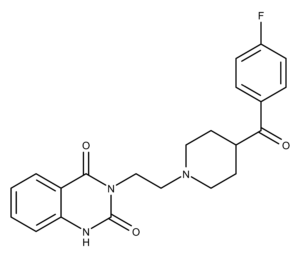The Chemistry of Ketanserin
Ketanserin belongs to a class of aromatic compounds called alkylphenylketones.1 As such, it has a ketone group substituted by a phenyl group and an alkyl group. Ketanserin is a weak base with a pKa = 7.5.2 It also has moderate lipophilicity, log P = 3.3 in the octanol-water system.
The Pharmacology of Ketanserin
Ketanserin is a serotonin receptor antagonist. Its existence and receptor binding profile was first reported by Leysen et al. of Janssen Pharmaceutica Research in 1981.3 Also, ketanserin in a potent antagonist of the histamine H1 receptor.4
Pharmacokinetic studies indicate that orally administered ketanserin is quickly and almost completely (>98%) absorbed by the body (see review in Persson et al).2 Peak plasma concentrations are achieved in 0.5 to 2 hours. In the blood, only about 5% of ketanserin remains free, while the rest binds to proteins in the plasma, primarily albumin. Less than 2% of ketanserin is excreted in the unchanged form. The compound is extensively metabolized, mostly by ketone reduction, creating ketanserin-ol which is excreted in the urine. Some of this metabolite is reoxidized in the body back to ketanserin.
The Applications and Potential of Ketanserin
Ketanserin is indicated for the treatment of hypertension. The mechanism of its hypotensive action via the blockade of α1-adrenoceptors was discovered by Fozard in 1982.5
Due to its antagonist capabilities, ketanserin is also used extensively to study the serotonin 5-HT2 receptor family. For example, in 2017, Preller et al. used ketanserin to block the 5-HT2A receptor for studying the subjective effects of LSD.6
